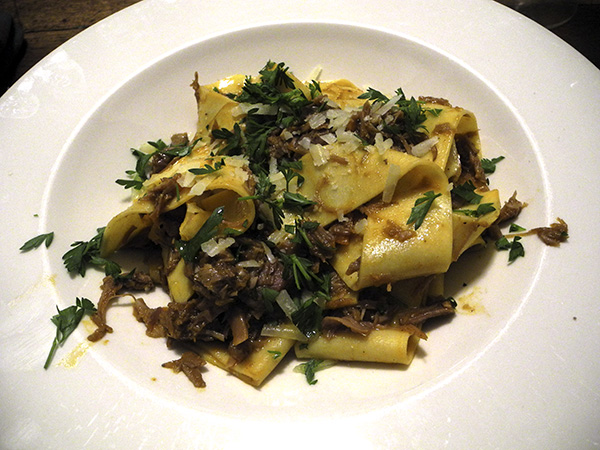
I don’t think I would ever cook a ragout (ragù/ragoute) from scratch in order to create a pasta sauce (I’m not sure anyone does, because of the nature of the thing), but after cooking and serving a goat leg last week, I thought that, with all the leftovers, the makings for one had fallen into my lap.
Apparently there is such a thing as too rich when it comes to food, as there is in just about anything else.
I had well over half a pound of some intensely aromatic slow-cooked meat, but there was no physical sign of the vegetables that had contributed to its flavor during the 4 and a half hours it had spent in the oven on Sunday. A ragout is expected to include vegetables, and maybe only vegetables, since the meat with which they are cooked is sometimes removed and reserved for another use once the sauce has been prepared.
On Tueday I was dealing with the opposite scenario. To make it work, I could have ‘built back in’ some vegetables, so that it would at least be some form of Italian ragù, but since this dinner was supposed to be simple and quickly-assembled, I just ‘built it out’ with some interesting fats and liquids, in order to adjust the flavor and create a sauce for my supply of dry chunks and ‘pulled’ pieces of goat.
In the end I felt it wasn’t totally satisfactory, perhaps because, in the absence of vegetables, the ragù was too concentrated, too rich, too, well, ..’meaty’.
Also, on reflection today, I realize that if I had taken a few minutes to cook and add a vegetable or two the goat leftovers could have been incorporated in still a third meal, and that would have saved cooking time, at least on a different day.
- ten ounces of boned braised leg of goat, plus some defrosted fat and stock remaining from a meal of pork belly, a pinch of crushed dried smoked seranno pepper from Eckerton Hill Farm, a freshly-ground mix of black pepper and other seeds or spices that had been accidentally been combined when I was preparing a dry marinade for that same pork belly meal and then decided to hold onto for future use (black pepper, fennel seeds cumin seeds, coriander seeds, star anise, white peppercorns, and whole clove), sea salt, tomato paste, water from the pasta pot, and a little olive oil, mixed inside a large antique copper pot into which 12 ounces of fresh papardelle from Luca Donofrio‘s fresh pasta shop inside Eataly’s Flatiron store, boiled carefully for little more than 2 minutes, or until barely cooked through, in a large amount of well-salted water, drained, some of the pasta water retained and added to the pan, everything stirred over a medium-high flame until the liquid had emulsified, then arranged inside shallow bowls, garnished with chopped parsley from Phillips Farms, some freshly shredded Sini Fulvi Pecorino Romano D.O.C. from Chelsea Whole Foods Market sprinkled on top, and some olive oil drizzled around the edges
- the wine was a Portuguese (Douro) red, Mateus Nicolau de Almeida, Trans Douro Express ‘Baixo Corgo’ 2015, from Flatiron Wines
- the music was Karl Nielsen’ 1906 comic opera, ‘Maskarade’, Denmark’s ‘national opera’ virtually from its premier, Ulf Schirmer conducting the Danish Radio Symphony Orchestra, the Danish National Radio Choir and the Danish Boys Choir, with Boje Skovus, Aage Haugland, Susanne Resmark, Gert Henning-Jensen, Michael Kristensen, Kurt Ravn, Johan Reuter, Bo Giles Nandfred, Marianne Rorholm, Bo Anker Hansen, Peter Fog, Susse Lillesoe, Hanna Hjort, Anette Simonsen, Henrietta Bonde Hansen, Flemming Jensen, Lars Pederson, and Poul Emborg